Choosing a CRM is about more than just picking the right software; it’s a strategic sales decision. And for B2B teams, the stakes are even higher.
You’re not managing quick, one-and-done purchases. You’re navigating long sales cycles and multiple stakeholders. On top of that, you manage high-value contracts that need follow-up, forecasting, and flawless timing.
In 2025, B2B buyers expect more of everything. More context and personalization, and faster responses. A good CRM helps you meet those expectations without adding complexity. A great one aligns your sales and support teams around every account.
In this guide, we’ll walk you through:
- What makes B2B CRM software different
- The essential features to look for
- How to build a CRM strategy that actually supports your sales cycle
- Top B2B CRMs to consider (based on team size and sales style)
What is a B2B CRM?
A B2B CRM (business-to-business customer relationship management tool) is a software that helps companies manage customer relationships with other businesses, rather than individuals.
While B2C CRMs focus on high-volume, short-cycle sales to individuals, B2B CRMs support longer sales cycles, larger deal sizes, and more complex decision-making processes.
A B2B CRM helps with:
- Managing accounts and contacts
- Tracking deals and pipelines
- Supporting team collaboration
- Automating repetitive tasks
- Analyzing past sales data, reporting and forecasting
Now let's see how that translates to basic features you should have in your next B2B CRM tool.
Specific B2B CRM features to look out for
Every good CRM software can be used to manage leads and customer relationships.
To work well in a B2B use case, your customer relationship management tool needs a slightly different toolset. Here are the features to look out for when shopping for B2B CRMs.
Account-based contact management
B2B sales means talking to several stakeholders in a company rather than one individual. Account-based contact management means you can organize many different contacts under one account.
This lets you track customer interactions, determine each stakeholder's role in the organization, and understand who makes the purchasing decision.
Example:
You're selling supply chain management software. You can create an account for the company, link the CTO, procurement officer, and IT manager, and log each person's interactions. This helps sales reps adjust the conversation to the interests of everyone involved, instead of communicating with everyone with one type of messaging.
Customizable sales pipelines
No two B2B sales processes are the same, and your CRM should adapt to match how you sell. Your ideal B2B CRM tool should let you adjust it to your unique process, whether qualification, discovery, proposal, or legal review.
Example:
A consulting company may create a pipeline with stages such as:
- "Needs Analysis"
- "Proposal Sent"
- "Stakeholder Alignment"
- "Contract Review".
This customized approach can help avoid bottlenecks in the sales funnel.
Quote and proposal management
In B2B sales, you can't usually tell the client exactly how much something may cost because the pricing model tends to be more complex. Instead, you need the ability to create custom quotes and proposals that your CRM can support.
This feature lets reps generate, send, and track quotes and proposals directly from the CRM.
Example:
You run a marketing agency, and you want to send a few different pricing options to a client. With a B2B CRM, you can generate a quote with pricing options and send it for e-signature.
Contract and deal value tracking
Having access to customer data, such as the contract's potential value, can make life easier for your reps and support business growth.
Example:
A SaaS company selling accounting software can tag a deal as $60,000 with a two-year term. With this knowledge, they prioritize this deal over several smaller deals, and they can accurately forecast revenue growth for the upcoming period.
Role-based permissions and team collaboration
CRMs are not just for sales teams. They're also meant for customer service teams, marketing, product, customer support, and just about anyone who needs access to client data. Within the CRM, you should be able to set different roles and permissions, helping everyone collaborate while keeping sensitive customer data secure.
Example:
A sales manager may view pipeline reports and reassign accounts, while a junior rep only sees their own leads. Meanwhile, a customer success rep can access closed-won accounts to manage onboarding.
Integration with ERP and support systems
If you want to enhance customer relationships in B2B, give those customers a seamless experience across channels, e.g., sales, billing, and support. A solid ERP integration keeps information consistent and removes data silos.
Example:
A manufacturer uses SAP for inventory and billing. Integrating SAP with the CRM allows the sales team to view a customer's outstanding invoices or delivery history before making a call.
Lead scoring and segmentation by firmographics
Not every lead is worth your time, and a B2B CRM can help you quickly prioritize who deserves a call or an email. Firmographic data in B2B CRMs, such as industry, company size, or location, helps teams prioritize accounts that match their ideal customer profile.
Example:
A cybersecurity vendor can assign higher scores to leads from finance or healthcare sectors with over 200 employees. This helps sales focus on accounts with higher ACV and likelihood to convert.
Multichannel engagement tracking
Managing customer relationships in B2B can get hectic because communications span across channels. The sales process can start with a cold email, continue over a call, then a demo, perhaps a LinkedIn message, and then back to an email.
A good CRM handles all of this without added friction. B2B CRMs let you track every interaction, helping you prevent miscommunication and ensure timely follow-ups.
Example:
A sales rep can see that a key contact replied to an email last week, had a Zoom meeting yesterday, and hasn’t yet responded on LinkedIn. Based on this information, they determine the next best step for improving customer engagement and closing the deal.
Recurring revenue tracking (for SaaS and service contracts)
The best B2B CRMs support tracking metrics such as MRR, ARR, renewal dates, customer lifetime value, churn, etc.
Example:
Suppose you run an IT support firm that tracks a $3,000/month support contract. You can use the CRM to set alerts 30 days before renewal to offer an upgraded service tier.
Custom reporting and forecasting
The more complex the sales process, the less likely standard reports are to meet your business needs. B2B CRMs support custom reports that measure sales cycle length, win rates by industry, or rep performance over time.
Example:
Let's say that you're a VP of Sales. You build a report showing how long deals take to close in the manufacturing sector versus tech. You discover manufacturing deals take 40% longer and assign a specialist to speed them up.
Features are only half the picture. Your strategy must match your sales motion if you want to get the most from your CRM.
How to align your CRM with your B2B sales process
Building a solid B2B CRM strategy means aligning your processes, teams, and tools with how your customers actually buy.
From managing complex accounts to supporting long-term relationships, the right approach helps your business stay organized and responsive while focusing on growth.
Below are the key elements every B2B team should include in their CRM strategy.
Account-based approach
A strong B2B CRM strategy starts with treating companies as the primary customer, not just individual contacts.
Instead of tracking isolated leads, an account-based approach allows your team to manage every stakeholder tied to a specific business. This is critical when deals involve multiple decision-makers, which is very common in B2B.
By grouping contacts under one company record, your team can see all interactions in one place, share notes, and plan coordinated outreach among themselves. Grouping also improves handoffs between sales, support, and account managers so no one misses critical information.
Capsule makes this easy with clear organization of people and organizations.
Long sales cycle nurturing
A good CRM strategy includes tools for task reminders, follow-up sequences, pipeline tracking, and more.
Long sales cycles also mean more opportunities for deals to stall or be forgotten. A CRM that flags inactivity, missed deadlines, or key contacts going quiet gives your team the edge to keep things moving. With a two-month sales cycle, this feature is very helpful.
With Capsule, you can set custom milestones, add notes on past conversations, and see where every opportunity stands, no matter how long the timeline.
Personalization and relationship building
Your CRM should help you track deals and the context behind them: who you’ve spoken to, what they care about. Perhaps most importantly, it helps you determine when to reach out next.
A personalized touch, such as referencing a previous meeting or remembering a client’s goals, can make the difference between a deal and a lost opportunity.
Capsule helps you build those relationships by capturing rich contact history, tagging contacts based on interests or roles, and setting reminders that keep your communication relevant and timely.
Advanced analytics and forecasting
A B2B CRM strategy should include sales forecasting, conversion analysis, and custom reporting.
This helps leaders understand which reps are performing well, which stages need improvement, and how close you are to hitting revenue goals. In short, what and who is working well?
Capsule’s reports give you visibility into open opportunities, projected deal values, and won/lost trends. You can filter by team, stage, or tag to see the actionable insights that matter most to your business.
Integration of multichannel touchpoints
Your CRM should be the place where all customer communication comes together.
A strong strategy includes capturing conversations from multiple channels and making them visible across the team. This prevents double outreach and makes your follow-ups more informed.
Capsule integrates with tools like Gmail, Outlook, Microsoft 365, and support systems, so your communications stay connected and your team works with the full picture.
Proactive customer service and post-sale follow-up
In B2B, the sale is just the beginning. Post-sale onboarding, support, and regular check-ins are key to keeping clients happy and renewing. Your CRM should support customer success just as much as sales.
Proactive follow-up, like reaching out before a renewal or checking in after implementation, helps you avoid issues and uncover upsell opportunities.
Capsule lets you assign tasks to team members, set timelines for follow-ups, and record every touchpoint, so you never lose momentum after a deal closes.
Top B2B CRM choices to consider in 2025 and beyond
The customer relationship management tool industry is crowded, and finding the right platform for your business operations can be a struggle. Below, we outlined the best CRM software options specifically for B2B sales.
Capsule CRM: best for small B2B teams that need a simple, customizable CRM
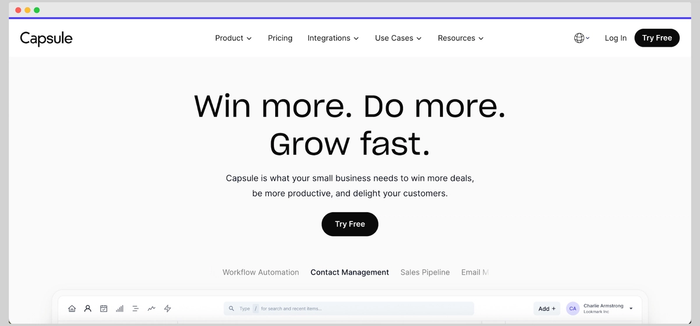
Capsule is a lean CRM built for small B2B teams that want structure without complexity. It keeps contacts and sales pipelines tightly organized, without burying you under features you'll never use.
For B2B companies with straightforward processes, Capsule delivers just the right balance of customization and simplicity.
Key features include:
- Centralized contact management: Store all contacts and companies in one place for a clear view of each B2B relationship, along with its history. Custom fields and tags let you tailor data to your business needs.
- Sales pipeline tracking: Visualize your deals through stages with an easy-to-use pipeline, which comes in handy with extremely long sales cycles. Drag-and-drop functionality and milestone tracking help teams focus on advancing opportunities and closing deals consistently.
- Task and project management: Assign tasks and use simple project boards to manage post-sale activities or implementations. This keeps everyone in the team accountable and prevents you from losing deals because of sheer forgetfulness.
- Email integration: Capture conversations by forwarding emails into Capsule or connecting a shared inbox. Team members see all email interactions with a client, which reduces your response time and makes sure no one sends the same email twice.
- Integrations with key apps: Capsule connects with tools like Xero or QuickBooks for invoicing and support platforms like Zendesk. Capsule’s open API and Zapier integrations extend its functionality into your existing B2B software stack.
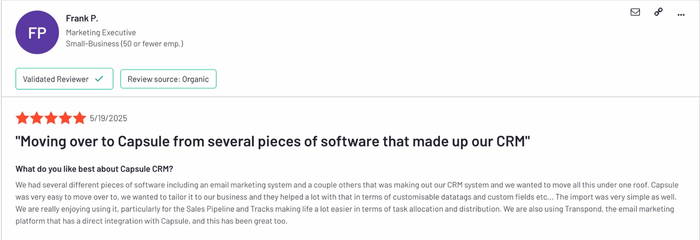
Capsule stands out because of its simplicity and ease of use.
Pricing: starts at $18 per user per month.
Considerations:
Unlike some B2B CRMs (which we'll talk about shortly), Capsule doesn't have built-in marketing or calling tools, so you'll have to integrate them.
Also, the more advanced Capsule features are locked into higher-tier plans. Before choosing Capsule, try the free version to determine which features your team needs. This will let you choose the most appropriate plan for your needs.
Salesforce: best for enterprise B2B organizations requiring extensive customization and scalability
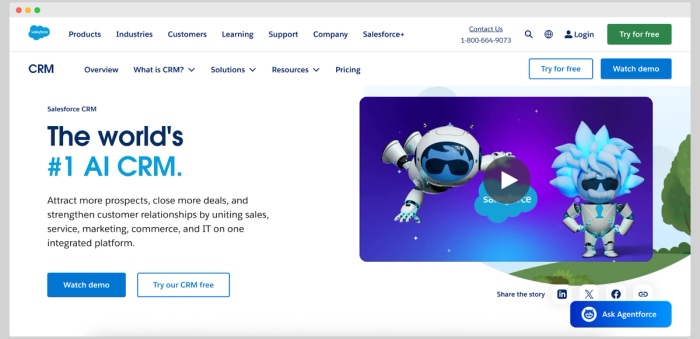
Salesforce is the go-to CRM for large B2B organizations with complex workflows and multiple teams.
Salesforce is a customizable platform that adapts to your business operations. If you need detailed reporting, layered permissions, and process automation across departments, this system can support that scale.
Some of its many features include:
- Extensive customization: Salesforce provides a highly customizable data model. Use it to create custom objects, fields and page layouts to mirror any B2B sales process. You can customize the CRM to adapt to complex workflows, such as approval processes or custom sales stages.
- Advanced sales automation: You can use Salesforce to automate repetitive tasks and complex processes through workflow rules and its Flow builder. There are many examples, from lead assignment to setting custom deal progression triggers.
- Robust reporting & analytics: Build custom dashboards and detailed reports for forecasting, pipeline analysis and your key performance indicators. For example, sales managers can monitor conversion rates and deal velocities across teams.
- Vast integration ecosystem: Salesforce’s AppExchange has thousands of integrations and add-ons, such as marketing platforms, ERP systems, support desks and many more to power up your sales strategies.
- AI and scalability: Using past data, the built-in Einstein AI can prioritize leads and predict outcomes (like which deals might close). Salesforce has a number of different plans, so you can start lean and upgrade as your needs (and team) grow.
Pricing: starts at $25 per user per month.
Considerations:
Even in the most basic plans, Salesforce can be extremely complex to set up. If you're new to CRMs, set aside some time for learning the ropes and setting up the CRM from scratch.
Salesforce is also not the cheapest CRM for B2Bs, especially if you need a considerable number of add-ons and upgrades. Evaluate your needs first to determine what comes with Salesforce out of the box, and what you have to purchase as an extra.
The biggest problem though, is that Salesforce can be just too much for small teams just getting started with a CRM. The sheer number of features can discourage your team from using Salesforce.

Salesforce comes with a steep learning curve, which may be too much for beginners.
PS. We also have a direct comparison between Salesforce and Capsule CRM.
Zoho CRM: best for growing B2B businesses that need an affordable all-in-one CRM suite

Zoho CRM offers a solid number of features at an attractive price point. If you already use other Zoho tools, the CRM can complete the full picture, letting you centralize sales, marketing efforts and customer support with several tightly integrated platforms. The learning curve is steeper compared to most competitors, but the all-in-one potential is hard to beat.
Its top features include:
- All-in-one functionality: Zoho CRM covers lead and contact management, deals, customer service and marketing integrations (especially if used with other Zoho products). You can use Zoho to manage the entire customer lifecycle in one ecosystem without many external tools.
- Sales automation and workflows: Set up workflow rules to automate follow-ups, lead scoring, or field updates. For instance, a new lead from your website can trigger an automatic task for sales or an email drip campaign, ensuring prompt nurturing without manual effort.
- Multichannel communication: Talk to leads and customers via email, phone, live chat, or social and track all the interactions in the CRM. Reps can log calls (or use Zoho’s phone bridge to call from the CRM) and see email interactions, so every touchpoint with a B2B prospect is documented.
- AI sales assistant (Zia): Zoho’s AI can predict deal closing probabilities and suggest the best times to contact a prospect. You can even use it to detect anomalies in your sales pipeline.
- Customization and extensions: Create custom fields/modules and customize the CRM for use in your industry. On top of that, the Zoho Marketplace offers many extensions, from telephony to e-signatures.
Pricing: Zoho pricing starts at $15 per user per month.
Considerations:
Zoho packs a lot of features for a CRM, but it can take some time to master the more advanced options. It's best suited for those teams where at least someone has previous Zoho experience.
The interface isn't very modern compared to other tools on this list, which may not be a huge issue. However, finding some features can be slightly difficult.
If you run into problems, the Zoho support team may not be very responsive if you're on the lower-tier plans. Last but not least, the integrations outside of the Zoho ecosystem may require more time for setup.
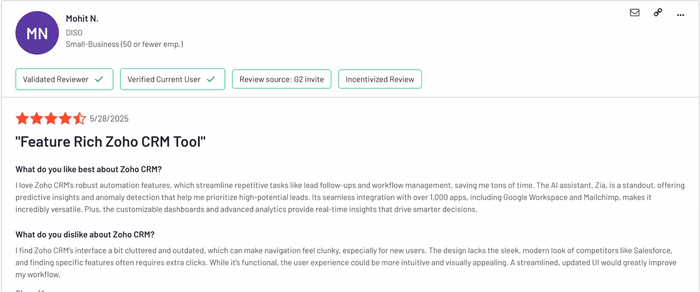
The dated interface is one of customers' most common complaints about Zoho CRM.
Hubspot: best for B2B companies that rely on inbound marketing and need tight sales-marketing alignment

HubSpot is best for B2B teams where marketing and sales collaborate closely. It puts lead capture, nurturing, and pipeline management in one shared space, making it easier to act on buyer signals.
It’s not the most customizable platform, but if your sales process is driven by inbound marketing activity, HubSpot can be a good choice.
The features are too many to list, but here are the ones most relevant for B2B sales:
- Unified marketing & sales platform: HubSpot combines a CRM with marketing tools (B2B email marketing, forms, landing pages) and customer service features. Your marketing team can capture and nurture leads, and sales can pick up those warm leads, all in one tool.
- Ease of use: The HubSpot interface is modern and very user-friendly. Adding contacts, logging activities, and moving deals through your pipeline is intuitive, even for teams with no previous CRM experience.
- Lead tracking and scoring: Every interaction (email opens, website visits, form fills) is tracked on the contact record. Sales reps can see what content a prospect engaged with, helping them customize their approach. Automatic lead scoring (available in higher tiers or with the AI features) highlights the hottest prospects.
- Email templates and sequences: HubSpot comes with email templates and automated sequences of follow-up emails. For example, after a demo, a rep can enroll the prospect in a sequence of personalized follow-ups over the next few weeks.
- Analytics and reporting: Measure the entire funnel from visitors to closed deals. HubSpot’s reports can attribute leads to marketing campaigns, show deal pipelines, and forecast revenue. Dashboards are easily customizable, too.
Pricing: HubSpot pricing starts at $105 per seat per month for the Sales Hub.
Considerations:
If you need a capable B2B CRM, the Starter plan in HubSpot won't suffice. All of the key features are locked in higher-tier plans. Speaking of which, adding new contacts and hubs can quickly increase your monthly HubSpot invoice.
If you have unique sales strategies and workflows, HubSpot can be limiting. While it does offer a strong marketing and sales integration, there is not much room for customization.
Last but not least, if you want to switch from HubSpot to another B2B CRM at some point in the future, users have pointed out that migration and export can be complicated.
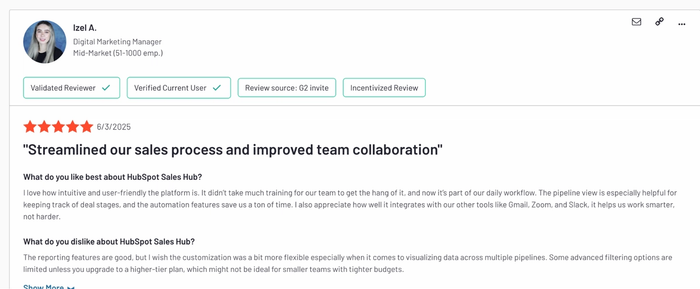
The lack of customization options is one of the most common complaints about Hubspot CRM.
Pipedrive: best for sales-focused B2B teams that need a straightforward, visual pipeline tool
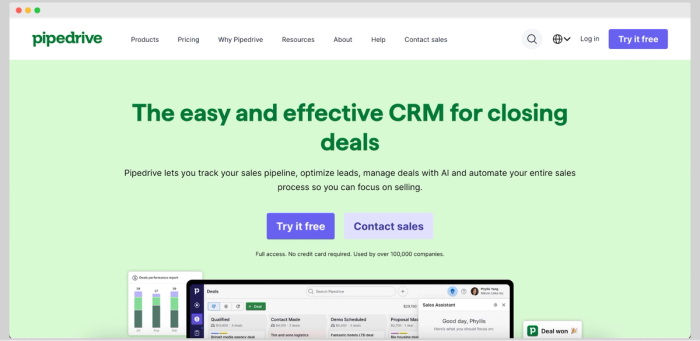
Pipedrive is a CRM built around sales activity.
For B2B teams focused on moving deals forward daily, it offers a highly visual and process-driven approach to managing pipelines. You won’t find marketing tools or service modules in Pipedrive, but you get a tight focus on selling that is built for lean teams.
Pipedrive's best features for B2B include:
- Visual deal pipeline: Pipedrive’s core is a kanban-style pipeline where each deal is a card that moves through stages. This view of all deals in progress lets sales reps manage their funnel, while managers can spot bottlenecks. It’s very drag-and-drop and intuitive.
- Activity and follow-up tracking: Pipedrive has a strong focus on scheduling next actions for every deal. You get reminders to make the call, send the email, or schedule the meeting, so you never accidentally lose a sale.
- Automation and AI assistance: Pipedrive includes a Sales Assistant (even on basic plans) that suggests tasks and can automate simple tasks and activities. For example, it can auto-create a follow-up task when a deal moves stages, or notify you if a high-value deal sits idle. This light automation increases consistency without extensive setup.
- Email integration: You can send and receive emails directly in Pipedrive (with plans that offer full sync), linking communications to deals. It also integrates with Gmail and Outlook, so messages to B2B clients are logged in the CRM. This keeps the communication history in one place.
- Third-party integrations: Pipedrive connects with popular tools like Google Workspace, Slack, and Zapier. Need to generate a proposal or invoice? Add-ons and integrations (e.g., PandaDoc or Xero) allow you to extend Pipedrive’s functionality as your needs grow.
Pricing: starts at $14 per user per month.
Considerations:
Compared to some competitors, such as Zoho or HubSpot, Pipedrive doesn't come with any built-in marketing or support features. The reports are fairly basic, and if you want to analyze your sales funnel or individual rep performance in more detail, they may not be enough.
Unlocking all the features will require you to purchase add-ons, which can quickly add up. Last but not least, Pipedrive is not very customizable compared to platforms like Capsule.
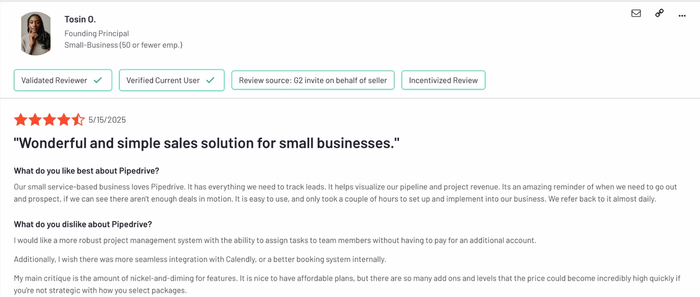
Pipedrive users frequently complain about the add-on costs that can significantly increase total CRM costs.
Close CRM: best for inside sales teams in B2B who heavily use calling and emailing for outreach
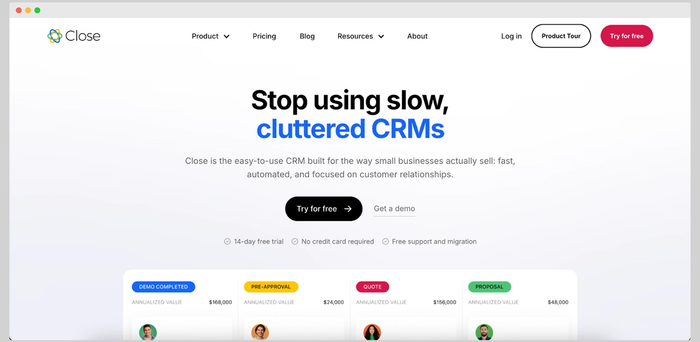
Close is built for inside sales teams working the phones and inbox daily. It combines outreach, pipeline tracking, and task management into one interface, helping you move faster without switching tools. It’s not built for marketing or post-sale support. However, it’s among the most efficient options for sales-driven B2B teams.
Top features in Close are:
- Built-in calling and SMS: Close has calling and text messaging built into the CRM. Reps can call leads directly from their browser, use the Power Dialer to rapidly go through call lists, and send texts to prospects. All calls and texts are automatically logged under each lead.
- Email sequences and tracking: Sales reps can set up multi-step email sequences to nurture leads (e.g., a series of outreach emails over two weeks). The system tracks email opens and replies, so you know precisely when a B2B prospect engages and can prioritize follow-ups in an email marketing customer journey.
- Multiple pipelines & lead organization: Manage different sales pipelines (for different products or teams) in one account. Close lets you segment leads and opportunities flexibly, with smart filters to quickly pull up, say, “Manufacturing industry leads in negotiation stage”. This is great for B2B teams handling various segments or product lines.
- Unified inbox and tasks: Every interaction (calls, emails, SMS) appears in a chronological feed for each lead, along with tasks. Reps work out of one inbox for all activities, so everyone has full context. If you talked to a contact last week, anyone on the team can see that call note before reaching out again.
- Automation (in higher plans): Close offers workflow automation tools on its higher tiers – like triggering a follow-up sequence when a lead’s status changes, or auto-assigning leads to reps. While not as elaborate as some larger CRMs, these automations help a lean sales team stay efficient and standardized in their outreach.
Pricing: starts at $35 per seat per month.
Considerations:
Close is more expensive than most of the competition for their starting plan. When you also consider that it's only a sales tool, with no marketing or customer service features, it can be difficult to justify the price.
It can't be customized to great lengths like Capsule, and some of the more advanced features, such as sequences and automation, will require time for training.
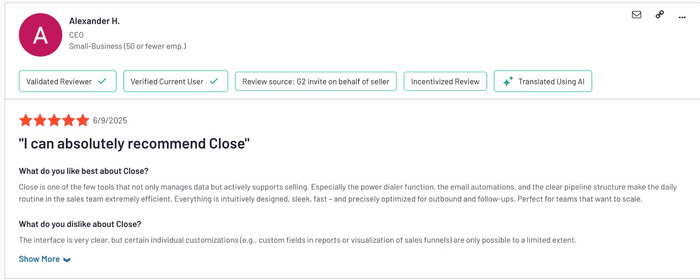
Complaints about customization options are common with Close.
Wrapping up
B2B sales is complex, but your CRM doesn’t have to be. The best tools support how your business actually works, helping you manage deals, deepen relationships, and forecast with confidence.
If you’re looking for a CRM that keeps things simple without skimping on the essentials, Capsule is built for B2B teams that value clarity, simplicity, and strong relationships.
Try it free and see how much smoother your sales process can be.




